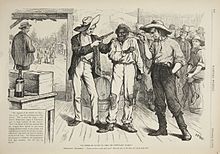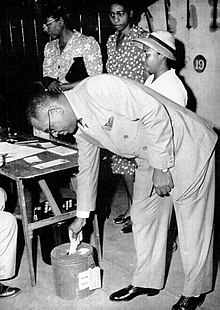Black suffrage in the United States

History


At the founding of the country, the right to vote was restricted to "gentlemen of property and standing"; most Black people did not own enough property to vote. Removal of the property requirements, so as to enfranchise poor whites, meant that Black people would be able to vote too, so the search began for other means to disenfranchise them. Early legal acts, like the
During this time, abolitionists sought to end slavery, and the call for suffrage grew. The 1857 Dred Scott decision held that persons of African heritage were not U.S. citizens. Rather than settling the issue, as President Buchanan hoped, it produced outrage and is a major item among the causes of the Civil War.
After the Civil War, the Fifteenth Amendment gave all males the vote, but in practice Black people still faced obstacles. Some of the "Black Codes" passed shortly after the legal abolition of slavery explicitly prevented Black people from voting. The Enforcement Acts increased federal penalties for voter intimidation, particularly by white terrorist groups such as the Ku Klux Klan.[5]
Black people seeking suffrage were often met with violence and
Black people continuously worked towards
The
Since the 1960s, the practice of gerrymandering—drawing the boundaries of each Congressional district, which are redone after every census, so as to maximize white and minimize Black political power—has been identified as a threat to black voting rights in the U.S.[9] The Supreme Court limited the Gomillion decision in Mobile v. Bolden (1980), distinguishing between racist effects and racist intent, and prohibiting only the latter. The Court ruled in Shaw v. Reno (1993) that if a redistricting plan is "so bizarre on its face that it is 'unexplainable on grounds other than race'", it must be held to a "strict scrutiny" standard under the Fourteenth Amendment.[further explanation needed] The Court has since struck down redistricting plans for racial gerrymandering in Miller v. Johnson (1995), Bush v. Vera (1996), and several more cases.[10] However, the Supreme Court struck down part of the Voting Rights Act in Shelby County v. Holder (2013), holding that the racist practices that necessitated the law in 1965 no longer existed in 2013.[6] Contrary to the Court's finding, jurisdictions then proceeded to make voting more difficult, closing polling places in Black neighborhoods, and requiring an official state ID to vote, something Black voters are less likely than white voters to have, while simultaneously closing offices where the IDs could be obtained. While claiming that these measures prevented voting fraud (which multiple investigations have found to be rare in the 21st-century United States), the clear result, and arguably the clear intent, was to reduce African-American voting in Southern states.[11][12][13][14][15][16][17][18]
Black women's suffrage movement

Black women began to work for political rights in the 1830s in New York and Philadelphia.
Even with having the amendment ratified Black women were kept from voting using violence and intimidation. Black women protested this in many ways. Some women such as Indiana Little marched to their local voting registrar office and demanded their right to vote.[22]
See also
- 1869 Convention of Colored Citizens of Minnesota
- The Ballot or the Bullet
- Black nationalism
- List of African American suffragists
- Racial Equality Proposal, 1919
- Mary Church Terrell
- Universal suffrage
- Women's suffrage in the United States
- Disfranchisement after the Reconstruction era
References
Notes
- ^ Hymowitz; Weissman (1975). A History of Women in America. Bantam.
- ISBN 9781573561488. Retrieved March 25, 2010.
- ^ "The American Revolution". www.nps.gov. Retrieved March 20, 2020.
- ^ "Black Philadelphians Defend their Voting Rights, 1838". The American Yawp Reader. Retrieved March 20, 2020.
- ^ JSTOR 2205188.
- ^ ISBN 0766012972.
- ISBN 978-0-230-61138-2.
- )
- ^ Li, Michael; Royden, Laura (October 17, 2017). "Does the Anti-Gerrymandering Campaign Threaten Minority Voting Rights?". Brennan Center.
- ^ See: Category:United States electoral redistricting case law
- ^ Weiser, Wendy R. (June 17, 2014). "The State of Voting in 2014". Brennan Center for Justice. Retrieved March 27, 2022.
- ^ Herron, Michael C.; Smith, Daniel A. (May 2019). Race, Shelby County, and the Voter Information Verification Act in North Carolina (PDF). Tallahassee, Florida: Florida State University College of Law. Retrieved March 27, 2022.
{{cite book}}:|work=ignored (help) - )
- ^ Doubek, James; Inskeep, Steve (May 13, 2019). "Black Church Leaders In Georgia On The Importance Of 'Souls To The Polls'". NPR. Retrieved December 6, 2021.
- ^ Brandeisky, Kara; Tigas, Mark (November 2013). "Which States Have Enacted Restrictions Since the Voting Rights Act Ruling?". The Atlantic. Retrieved March 27, 2022.
- ^ "Warning Signs: The Potential Impact of Shelby County v. Holder on the 2016 U.S. Election" (PDF). New York City: American Civil Liberties Union. June 2016. Retrieved March 27, 2022.
- ^ Fuller, Jaime (July 7, 2014). "How has voting changed since Shelby County v. Holder?". The Washington Post. Retrieved July 2, 2015.
- ^ "Election 2016: Restrictive Voting Laws by the Numbers". Brennan Center for Justice. Retrieved December 22, 2018.
- ISBN 1-55849-058-2.
- ISBN 0688019439.
- ISBN 9781541618619.
- ^ Royster, Briana Adline (2019). "Biographical Sketch of Indiana T. Little". search.alexanderstreet.com. Alexander Street. Archived from the original on December 8, 2021. Retrieved December 8, 2021.
Further reading
- Bateman, David (2020). "Partisan Polarization on Black Suffrage, 1785–1868". Perspectives on Politics. 18 (2): 470–491. .
- Bateman, David (2018). Disenfranchising Democracy: Constructing the Electorate in the United States, the United Kingdom, and France. Cambridge: Cambridge University Press. ISBN 9781108470193.
- Robinson, George M. Fredrickson Edgar E. (1995). Black Liberation: A Comparative History of Black Ideologies in the United States and South Africa. Oxford University Press. ISBN 978-0195109788.
External links
- "How the Suffrage Movement Betrayed Black Women".
- "How Black Suffragists Fought for the Right to Vote and a Modicum of Respect".
{{cite journal}}: Cite journal requires|journal=(help) - "Votes for Women means Votes for Black Women".
- "Weekend Read: Challenging the whitewashed history of women's suffrage".
- "The 19th Amendment Only Really Helped White Women". August 16, 2019.
